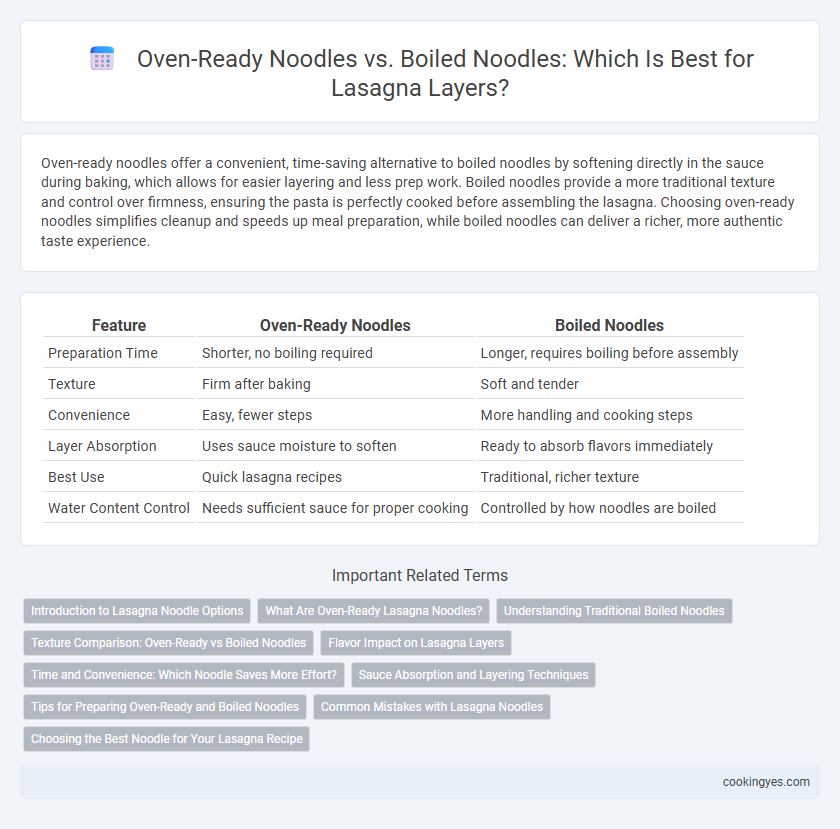Oven-ready noodles offer a convenient, time-saving alternative to boiled noodles by softening directly in the sauce during baking, which allows for easier layering and less prep work. Boiled noodles provide a more traditional texture and control over firmness, ensuring the pasta is perfectly cooked before assembling the lasagna. Choosing oven-ready noodles simplifies cleanup and speeds up meal preparation, while boiled noodles can deliver a richer, more authentic taste experience.
Table of Comparison
| Feature | Oven-Ready Noodles | Boiled Noodles |
|---|---|---|
| Preparation Time | Shorter, no boiling required | Longer, requires boiling before assembly |
| Texture | Firm after baking | Soft and tender |
| Convenience | Easy, fewer steps | More handling and cooking steps |
| Layer Absorption | Uses sauce moisture to soften | Ready to absorb flavors immediately |
| Best Use | Quick lasagna recipes | Traditional, richer texture |
| Water Content Control | Needs sufficient sauce for proper cooking | Controlled by how noodles are boiled |
Introduction to Lasagna Noodle Options
Oven-ready noodles simplify the lasagna-making process by eliminating the need for pre-boiling, absorbing sauce and moisture during baking to achieve a tender texture. Boiled noodles require prior cooking, offering greater control over texture and preventing potential dryness by locking in moisture before layering. Both options impact the overall consistency and preparation time, influencing the final quality of classic lasagna dishes.
What Are Oven-Ready Lasagna Noodles?
Oven-ready lasagna noodles are precooked pasta sheets specifically designed to be used without boiling, saving preparation time and reducing mess. These noodles absorb sauce moisture during baking, ensuring tender layers while maintaining structure within the lasagna. Unlike boiled noodles, oven-ready varieties require adequate sauce coverage to soften properly and prevent dryness in the finished dish.
Understanding Traditional Boiled Noodles
Traditional boiled noodles for lasagna offer a tender texture that easily absorbs rich sauces and flavors during baking. Boiling noodles beforehand ensures they cook evenly and prevents dryness, contributing to a well-balanced, moist lasagna. In contrast to oven-ready noodles, boiled pasta provides a more authentic mouthfeel and consistency preferred in classic Italian recipes.
Texture Comparison: Oven-Ready vs Boiled Noodles
Oven-ready lasagna noodles offer a firmer texture after baking due to their thinner, par-cooked construction that absorbs sauce during cooking, resulting in distinct, slightly al dente layers. Boiled noodles yield a softer, more pliable texture that melds with sauces for a creamier, more cohesive bite. Choosing between oven-ready and boiled noodles significantly influences the final texture and overall mouthfeel of the lasagna, with oven-ready noodles providing a chewier contrast and boiled noodles delivering a tender, uniformly soft profile.
Flavor Impact on Lasagna Layers
Oven-ready noodles absorb sauce directly during baking, enhancing the flavor depth of each lasagna layer by allowing sauces to meld seamlessly into the pasta. Boiled noodles have a softer texture but can dilute the intensity of flavors if overcooked or rinsed, potentially resulting in less pronounced taste in the layers. Choosing oven-ready noodles often leads to a more robust, integrated flavor profile throughout the lasagna.
Time and Convenience: Which Noodle Saves More Effort?
Oven-ready noodles significantly reduce preparation time by eliminating the boiling step, allowing for a quicker and more convenient layering process. Boiled noodles require pre-cooking, adding both time and an extra pot to clean, which can complicate meal prep. Choosing oven-ready noodles provides a hassle-free approach that saves effort, making lasagna assembly faster and simpler.
Sauce Absorption and Layering Techniques
Oven-ready noodles offer superior sauce absorption due to their porous texture, allowing flavors to infuse deeply without pre-cooking. Boiled noodles require precise layering to prevent sogginess, as their moisture content can dilute the sauce balance. Optimizing sauce consistency and layering order enhances texture, creating distinct, flavorful pasta layers in lasagna.
Tips for Preparing Oven-Ready and Boiled Noodles
When preparing lasagna, oven-ready noodles save time as they absorb sauce during baking, requiring slightly more sauce to ensure proper hydration, while boiled noodles need careful timing to avoid overcooking and becoming mushy. For oven-ready noodles, use a thinner layer of sauce to prevent sogginess, and add a little extra water if the sauce is thick to help the noodles soften evenly. Boiled noodles benefit from rinsing in cold water to stop cooking and prevent sticking, and layering immediately after boiling ensures optimal texture and prevents dryness.
Common Mistakes with Lasagna Noodles
Using oven-ready noodles without adequately moistening them often results in dry, undercooked layers in lasagna, a common error among home cooks. Boiled noodles, while more forgiving, can become overly soft and prone to tearing if overcooked or handled roughly during layering. Ensuring a balance between moisture and texture by properly soaking oven-ready noodles and closely monitoring boiling time for traditional noodles prevents these frequent pitfalls and creates perfect pasta layers.
Choosing the Best Noodle for Your Lasagna Recipe
Oven-ready noodles offer convenience and a firmer, less mushy texture as they absorb sauce during baking without pre-cooking, making them ideal for quick lasagna recipes. Boiled noodles provide greater flexibility in layering and texture control, allowing chefs to customize doneness and achieve a softer, more traditional pasta feel. Selecting the best noodle depends on your lasagna style, cooking time, and desired consistency, with oven-ready suited for speed and ease, while boiled noodles cater to classic, artisanal preparations.
Oven-ready noodles vs Boiled noodles for pasta layers Infographic

 cookingyes.com
cookingyes.com